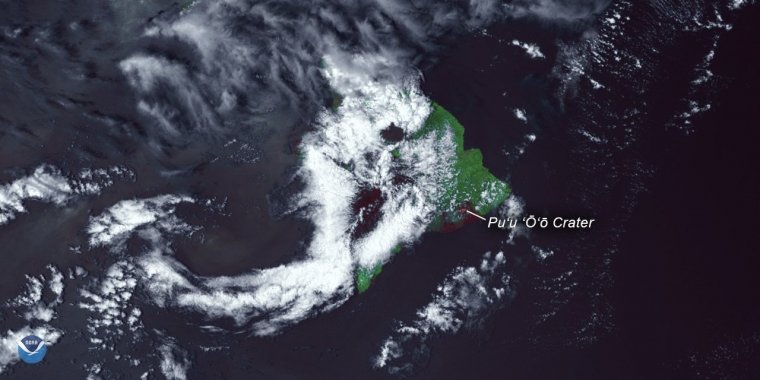| News / Science News |
Scientists report skyrocketing phyotplankton population in aftermath of Kīlauea eruption
A report by a team from the University of Hawaii at Mānoa (UH Mānoa) and the University of Southern California (USC), say the eruption of the Kīlauea volcano last year has been followed by a dramatic increase in the population of phytoplankton, also called green algae, in the waters surrounding the island.

Kīlauea erupting in 2018. Photo: NOAA National Environmental Satellite, Data, and Information Service (NESDIS)
According to the hypothesis of the report, the microbe population grew because there was suddenly a large quantity of nitrates in the water for them to feed on. Although the lava itself was low in nitrates, it heated the deeper layers of nutrient-rich water. This upward current brought the nitrates nearer to the surface, where phytoplankton, which also need sunlight, tend to live.
UH Mānoa dispatched the research ship Ka'imikai-O-Kanaloa from July 13 to 17 of last year, when Kīlauea was still erupting, and it sailed very close to where the lava entered the ocean so researchers could study the organisms and water chemistry there.
The expedition in July 2018 provided a unique opportunity to see first-hand how a massive input of external nutrients alters marine ecosystems that are finely attuned to low-nutrient conditions. Ecosystem responses to such a substantial addition of nutrients are rarely observed or sampled in real time.
The mass of microbe-rich water, called a plume, was large enough to detect from space. The research team used both satellite images and subsurface gliders to study the water.
The authors had initially hypothesized the lava itself would cause an increase in microbes that rely on iron and phosphates by directly supplying them with those nutrients. They found there was so much iron and phosphate that the particles coalesced into clumps where these microbes could not get to them. Other microbes, dependent on nitrates, came to dominate the plume instead.
Unlike red algae, whose blooms can damage the ecosystem, green algae form the basis of the food chain, providing food for crustaceans and larger organisms. A similar volcanic eruption in Alaska in 2008 was found to be associated with an increase in the local salmon population. Green algae also absorb carbon dioxide and produce oxygen.
The researchers have speculated this upwelling pattern may have occurred repeatedly during the volcanic process that produced the Hawaiian Island chain. (Wikinews)
YOU MAY ALSO LIKE





